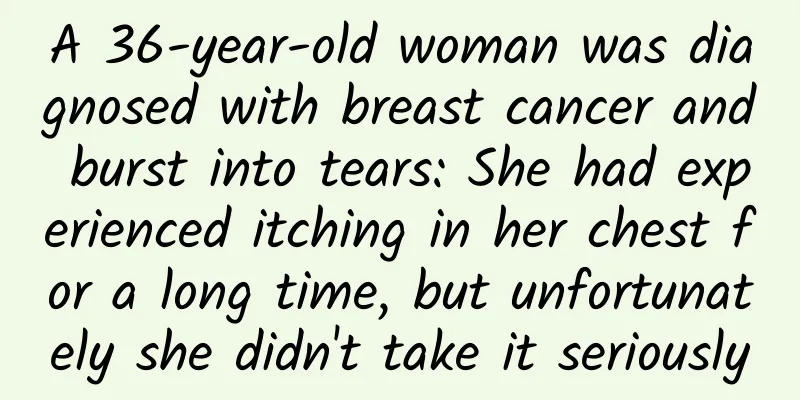A 36-year-old woman was diagnosed with breast cancer and burst into tears: She had experienced itching in her chest for a long time, but unfortunately she didn't take it seriously

|
If Xiao Li had known that itchy breasts were a sign of breast cancer, she would not have regretted it so much. She was 36 years old, beautiful and smart, but she was diagnosed with breast cancer during an accidental physical examination. That day, she sat in my office, tears and regret intertwined, and she cried, "Doctor, if I had known that itchy breasts were not a trivial matter, I would definitely not ignore it..." Dear friends, do you know? Our body is like a castle, and the mammary gland is a precious pagoda in the castle. When this pagoda begins to "itch", it may be the castle's alarm ringing, reminding us that an "uninvited guest" is visiting. Xiao Li's story is a lesson that each of us needs to be alert to. Xiao Li's breasts were itchy, and at first she thought it was due to dry skin or the wrong material of her underwear, so she didn't pay much attention. Who would have thought that this itchy "little trouble" is actually an early sign of breast cancer. Breast cancer doesn't always appear as a lump; sometimes it can lurk around you in the form of itching, skin changes, or nipple discharge. Doctors remind you: Don’t ignore these early signs of breast cancer. Test yourself to see if you have them! Breast lump: One of the main symptoms of breast cancer is a hard lump with irregular edges in the breast. The lump may be located anywhere in the breast but is most common in the upper outer quadrant. Nipple discharge: Nipple discharge in non-pregnant women is mostly pathological changes, of which intraductal papilloma accounts for about half, followed by cystic hyperplasia of the breast and mammary duct ectasia, and about 15% of patients have breast cancer. Bloody discharge may have a higher risk of becoming cancerous. Breast skin changes: Breast cancer may cause the skin of the breast to wrinkle or inward to form "dimples," or to develop "orange peel" changes, where many small depressions appear on the skin of the breast, similar to the peel of an orange. Abnormal nipple shape: The nipple may appear inverted or elevated, sometimes with an itchy sensation. Breast itching and pain: Breast cancer patients may experience breast itching and pain. The pain may be caused by compression or traction of the tumor tissue on the surrounding structures. Swollen axillary lymph nodes: Breast cancer may cause swollen axillary lymph nodes. The swollen lymph nodes are hard, scattered, and movable. If you notice any of these symptoms, see your doctor as soon as possible. Early detection and treatment of breast cancer are crucial to improving cure rates. Many patients are curious, is it possible to cure early breast cancer? Yes, early-stage breast cancer has a high chance of being cured. According to the latest information, the cure rate of early breast cancer can reach 80% to 90%. This means that if breast cancer can be detected early and treated in time, most patients have a chance of being cured. Early treatment of breast cancer usually includes comprehensive treatment methods such as surgery, chemotherapy, and radiotherapy. Surgery is the main treatment option, and breast-conserving surgery or total mastectomy is usually chosen based on the patient's specific circumstances. After surgery, you may need chemotherapy, radiation therapy, or other adjuvant therapy to destroy cancer cells in your body. I suggest that women over 20 should have regular breast examinations. If possible, it is best to have a cancer prevention physical examination once a year. Especially people over 40 should undergo breast ultrasound examinations every year. In short, early detection, early diagnosis, and early treatment are the key to improving the cure rate of breast cancer. If you have any doubts or concerns, we recommend that you consult your doctor or professional medical provider. So, how do we determine whether we are at high risk of breast cancer? People at high risk of breast cancer can be identified based on the following factors: Genetic family history: There is a family history of breast cancer or ovarian cancer, especially if someone in the immediate family has had breast cancer. Personal medical history: history of breast biopsy or surgery for benign breast disease, or history of pathologically confirmed atypical hyperplasia of the breast (lobular or ductal). Lifestyle and environmental factors: such as long-term smoking, drinking, high-fat diet, obesity, long-term use of estrogen replacement therapy, etc. Physiological factors: early age of menarche (under 12 years old) or late age of menopause (over 55 years old), no breastfeeding history or short breastfeeding period, late age of first childbirth (over 30 years old), etc. History of chest radiation therapy: A history of chest radiation therapy, especially in patients who received radiation therapy at a young age. Screening recommendations for people at high risk of breast cancer For people at high risk of breast cancer, more frequent and personalized screening strategies are recommended. Specific screening methods may include: Breast ultrasound: Since ultrasound examination is not affected by glandular density, it is suitable as the preferred method for breast cancer screening. Genetic testing: For individuals with a family history of breast cancer, genetic testing is performed to assess the risk of carrying a susceptibility gene mutation. Clinical breast examination: A comprehensive breast examination performed by a professional physician can detect some lesions that are difficult to detect with imaging examinations. Breast Self-Examination: Women are encouraged to perform regular self-examinations to increase awareness and vigilance regarding breast health. People at high risk of breast cancer should undergo regular screening using the above methods and discuss a personalized screening plan with their doctor. If you think you may be at high risk for breast cancer, it is recommended that you consult your doctor or professional medical service agency for more detailed guidance and advice. Healthy living is not a sprint, but a marathon. We cannot wait until the body "cries loudly" before we care about it, but we should pay attention to it when it "cries softly". Regular breast self-examination and professional examination are like regular patrols of the castle to detect any possible "invaders" in time. So, dear friends, let us be smart "castle owners" and be sensitive to every subtle change in the body. Remember, your body is your home and your treasure. If there is a problem with your chest, don't let it "cry silently", seek medical treatment in time, and let health always protect your smile. Let us work together, with knowledge and care, to build a solid line of defense to fight against breast cancer, this "uninvited guest"! |
>>: Reminder to women: These 5 behaviors will hurt the vagina. Do you do them often?
Recommend
What to do to stay healthy if you have Bartholinitis
The cause of Bartholin's glanditis is imprope...
What are the harms of uterine effusion to the body?
In the eyes of many women, uterine effusion is co...
Can borneol treat cervical erosion?
Can borneol treat cervical erosion? Experts sugge...
What is uterine fibroids?
Women with uterine fibroids will seriously affect...
Two most effective methods of treating ovarian cysts
At present, the most effective methods for treati...
Causes of miscarriage
Causes of miscarriage: There are many reasons for...
What to do if pelvic inflammatory disease is very painful? Relieve local pain
If you suffer from pelvic inflammatory disease an...
What are the common types of vaginitis?
What are the common types of vaginitis? Experts s...
Which department should I go to for examination of anterior uterine wall fibroids? Is anterior uterine wall adenomyosis serious?
Which department should I go to for examination o...
What are the consequences of abortion for pelvic inflammatory disease? Cause severe cervical erosion
In fact, in clinical practice, many women who nee...
Explain the main factors affecting the cost of abortion surgery
The cost of abortion is also a matter of great co...
Is it normal to have menstruation 50 days after miscarriage?
Is it normal to have menstruation 50 days after m...
What harm will pelvic effusion cause? How to deal with the harm of pelvic effusion?
Pelvic effusion is extremely harmful to women'...
Let me introduce the early symptoms of adnexitis
Adnexitis is a common gynecological disease. In l...
Pay more attention to atrophic vulvar leukoplakia
What is atrophic vulvar leukoplakia? Women must w...









